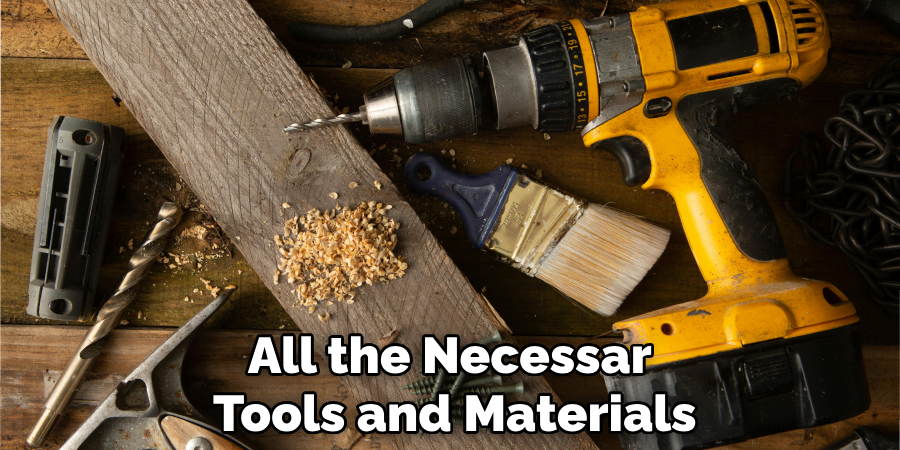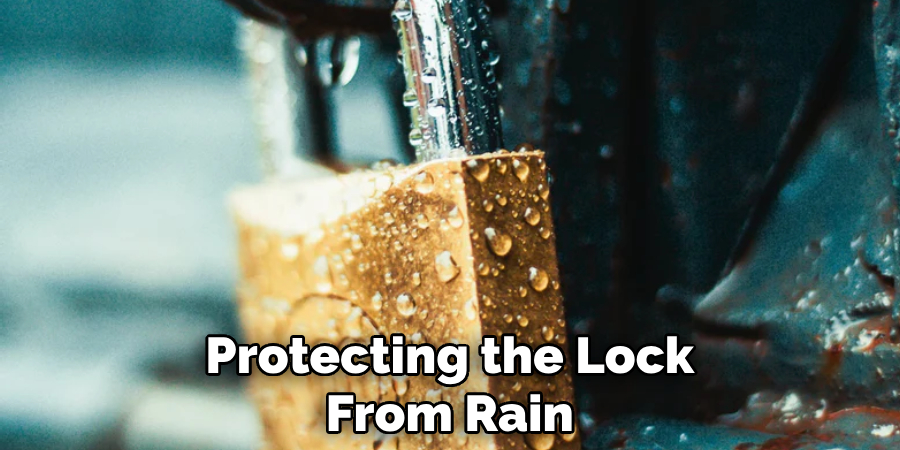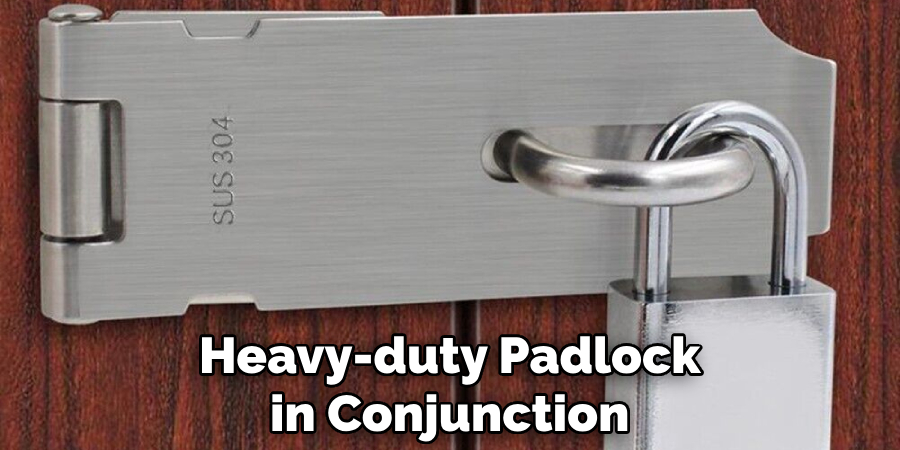Are you wondering if it is possible to lock your barn door from the outside? The answer is yes! In this guide, we will walk you through the steps on how to lock barn door from outside.

Securing your barn protects valuable equipment and livestock and ensures peace of mind. Locking a barn door from the outside might seem straightforward, but there are various methods and mechanisms tailored to fit different types of doors and security needs.
In this guide, we will walk you through the essential steps and provide tips on how to effectively lock your barn door from the outside, highlighting the tools and techniques that can enhance the security of your barn. Whether you have a traditional wooden barn or a more modern structure, understanding these methods will help you choose the best solution for your specific situation.
What Will You Need?
To successfully lock your barn door from the outside, you will need the following tools:
- Padlock: This type of lock consists of a metal shackle attached to a body. It can easily be locked by inserting its key or combination code and released using the same method.
- Hasp and Staple: This locking mechanism features a hinged metal fastener attached to a staple. The hasp swings over the staple, securing it within its clasp.
- Latch: A latch is a simple yet effective mechanism that keeps your barn door shut securely without requiring any external locking mechanism.
- Keyed Entry Set: This type of lock requires a key to lock and unlock the door. It typically has a doorknob or lever on one side and a keyed cylinder on the other.
Depending on your barn’s design, you may need additional tools such as screws, screwdrivers, and measuring tape to ensure proper installation of the locking mechanisms.
10 Easy Steps on How to Lock Barn Door From Outside
Step 1. Choose the Appropriate Lock:
Start by selecting the most suitable lock for your barn door. Consider factors like the type of door, the level of security required, and ease of use. Popular choices include padlocks, hasps and staples, latches, and keyed entry sets.
Step 2. Gather Your Tools:
Before you begin the installation process, ensure you have all the necessary tools and materials. This may include the chosen lock, screws, a screwdriver, a measuring tape, and any other items specified by the lock manufacturer’s instructions. Having everything ready will make the installation process smoother and more efficient.

Step 3. Prepare the Door Surface:
Ensure that the surface of the door where the lock will be installed is clean and smooth. Remove any debris, old paint, or rust that could interfere with the installation. If necessary, sand down the surface to create a flat and even area for attaching the lock components. This preparation will help achieve a secure and stable installation of your chosen locking mechanism.
Step 4. Mark the Installation Points:
Using a measuring tape and a pencil, mark the exact points on the door and the door frame where the lock components will be installed. Accuracy is crucial at this stage to ensure that the lock operates smoothly and effectively. Follow the manufacturer’s instructions for precise measurements and placement. Double-check your markings before proceeding to the next step to avoid any drilling errors.
Step 5. Drill Holes for the Lock Components:
With your markings in place, it’s time to drill the necessary holes for the lock components. Use an appropriate drill bit that matches the size of the screws included with your lock. Carefully and steadily drill the holes at the marked points on the door and the door frame. Maintaining steady pressure and control while drilling is important to avoid splintering the wood or damaging the surface. Ensure that the holes are drilled straight and not at an angle, as this could impede the proper alignment and function of the lock.

Step 6. Install the Lock Components:
Begin by attaching the lock components, such as the hasp, staple, or latch, to the designated areas of the door and door frame. Use the screws provided with the lock and a screwdriver to secure each piece firmly in place. These components must be correctly aligned to ensure smooth operation. Tighten the screws fully but be cautious not to overtighten, which could strip the screw holes or damage the locking mechanism. Verify that each part is securely fastened and aligned correctly.
Step 7. Test the Lock Mechanism:
Once the lock components are installed, it’s crucial to test the mechanism to ensure it works correctly. Close the barn door and engage the lock to see if it fits and locks smoothly. If you find any resistance or misalignment, make the necessary adjustments. This step helps to identify any potential issues before completing the installation, ensuring that your lock provides both security and ease of use.
Step 8. Secure Additional Reinforcements (If Needed):
Depending on the level of security you desire, you might want to add extra reinforcements to your barn door. This could include adding a secondary lock, reinforcing the door frame with metal braces, or even installing a security bar. These additional measures can provide an added layer of protection, especially if your barn contains valuable equipment or livestock. Consider your specific security needs and adjust accordingly.
Step 9. Weatherproof the Lock:
Barns are exposed to various weather conditions, so protecting the lock from elements like rain, snow, and humidity is important. Apply a weatherproof sealant or spray to the lock and its components to prevent rust and corrosion. This will extend the lifespan of your lock and ensure it remains functional throughout different weather conditions. Regular maintenance, such as lubricating the lock with suitable oil, can also help maintain its efficiency.

Step 10. Regularly Inspect and Maintain the Lock:
To keep your barn secure, regularly inspect the lock and its components for any signs of wear or damage. Check for rust, loose screws, or any difficulty in locking or unlocking the door. Address any issues promptly to maintain the integrity of your locking mechanism. Regular maintenance will not only prolong the life of your lock but also ensure continuous security for your barn.
By following these steps, you can effectively lock your barn door from the outside, ensuring that your property remains secure. Taking the time to select the right lock, properly install it, and maintain it will provide you with peace of mind, knowing that your barn is well-protected.
5 Additional Tips and Tricks
- Slide Bolt Latch: Install a sturdy slide bolt latch at the upper or lower section of the door. This type of latch is easy to operate and adds an extra security layer.
- Padlock and Hasp: Use a heavy-duty padlock in conjunction with a high-quality hasp. Ensure that the hasp is securely fastened to the door and the frame to prevent tampering.
- Cane Bolt: Add a cane bolt at the bottom of the barn door. This bolt drops into a hole in the ground or a metal sleeve attached to the ground, preventing the door from being opened.
- Keyed Deadbolt: Install a keyed deadbolt for enhanced security. This type of lock requires a key to open from the outside, providing robust protection against unauthorized access.
- Barrel Bolt: To keep the door securely closed, use a barrel bolt mounted to the back of the door that slides into a keep attached to the door frame. This is an effective and simple method.

With these additional tips and tricks, you can maximize the security of your barn door and ensure that your valuable belongings are well-protected.
5 Things You Should Avoid
- Using Inadequate Hardware: Avoid using low-quality locks and latches that can be easily broken or tampered with. Invest in robust, durable hardware to ensure maximum security.
- Neglecting Weather Protection: Do not ignore the effects of weather on your locking mechanisms. Exposure to rain, snow, and humidity can cause rust and deterioration. Use weather-resistant locks and regularly maintain them.
- Overlooking Regular Maintenance: Failing to routinely check and maintain your locks can lead to unexpected failures. Regularly inspect all locking mechanisms for wear and tear and replace any damaged components immediately.
- Installing Locks Incorrectly: Ensure that locks and latches are installed properly according to the manufacturer’s instructions. Incorrect installation can reduce the effectiveness of your security measures and make the barn door vulnerable to forced entry.
- Relying on a Single Locking Mechanism: Relying solely on one type of lock can be risky. Diversify your security approach by using multiple locking mechanisms such as deadbolts, padlocks, and slide bolts to create multiple layers of protection.
By avoiding these common mistakes, you can ensure that your barn door remains secure and serves its purpose effectively.
Conclusion
How to lock barn door from outside requires a thoughtful approach that incorporates multiple layers of protection.
By utilizing a combination of locks such as slide bolt latches, padlocks with hasps, cane bolts, keyed deadbolts, and barrel bolts, you can significantly enhance the security of your barn. Investing in high-quality hardware, protecting against weather damage, performing regular maintenance, ensuring proper installation, and utilizing more than one type of locking mechanism is crucial.
Following these tips and avoiding common pitfalls ensures your barn door remains secure and your valuable belongings are well-protected.
You Can Check It Out to Fix a Broken Lock.
About
Safety Fic is a distinguished figure in the world of Diy design, with a decade of expertise creating innovative and sustainable Diy solutions. His professional focus lies in merging traditional craftsmanship with modern manufacturing techniques, fostering designs that are both practical and environmentally conscious. As the author of diy, Safety Fic delves into the art and science of Safety Fic-making, inspiring artisans and industry professionals alike.
Education RMIT University
(Melbourne, Australia) Associate Degree in Design (Safety Fic) Focus on sustainable design, industry-driven projects, and practical craftsmanship. Gained hands-on experience with traditional and digital manufacturing tools, such as CAD and CNC software.
Nottingham Trent University
(United Kingdom) Bachelor’s in diyfastly.com and Product Design (Honors) Specialized in product design with a focus on blending creativity with production techniques. Participated in industry projects, working with companies like John Lewis and Vitsoe to gain real-world insights.
Publications and Impact
In diy, Safety Fic his insights on indoor design processes, materials, and strategies for efficient production. His writing bridges the gap between artisan knowledge and modern industry needs, making it a must-read for both budding designers and seasoned professionals.
